Abstract
Neutrophil cathepsin G and thrombin, the only platelet agonists that are proteases, exhibit a mandatory requirement for catalytic activity to induce platelet aggregation and signal transduction. The thrombin receptor is a G-protein-coupled receptor which undergoes proteolysis to generate a tethered ligand that causes self-activation. Since cathepsin G strongly resembles thrombin in its ability to activate platelets, we have attempted to determine whether cathepsin G and thrombin function through the same or different receptors. Evidence that thrombin and cathepsin G act at different receptors was as follows: (a) an antibody directed against the thrombin receptor blocked thrombin-induced but not cathepsin G-induced platelet responses; (b) human fibroblasts responded to thrombin and to a synthetic thrombin receptor peptide (comprising residues 42-55 of the thrombin receptor) by exhibiting an elevation in cytosolic Ca2+ concentration but did not respond to cathepsin G; and (c) platelets pretreated with neutrophil elastase failed to respond to thrombin but responded when rechallenged by cathepsin G. Thrombin and cathepsin G exhibit heterologous desensitization that is potentiated by okadaic acid and is attenuated by staurosporine, indicating that phosphorylation of serine/threonine residues is important for desensitization and that protein kinase C may be involved. Since catalytic activity of cathepsin G is required for platelet stimulation, it is probable that platelet activation by cathepsin G requires receptor proteolysis and that a tethered ligand mechanism is involved, suggesting that platelets may possess a family of protease receptors.
Full text
PDF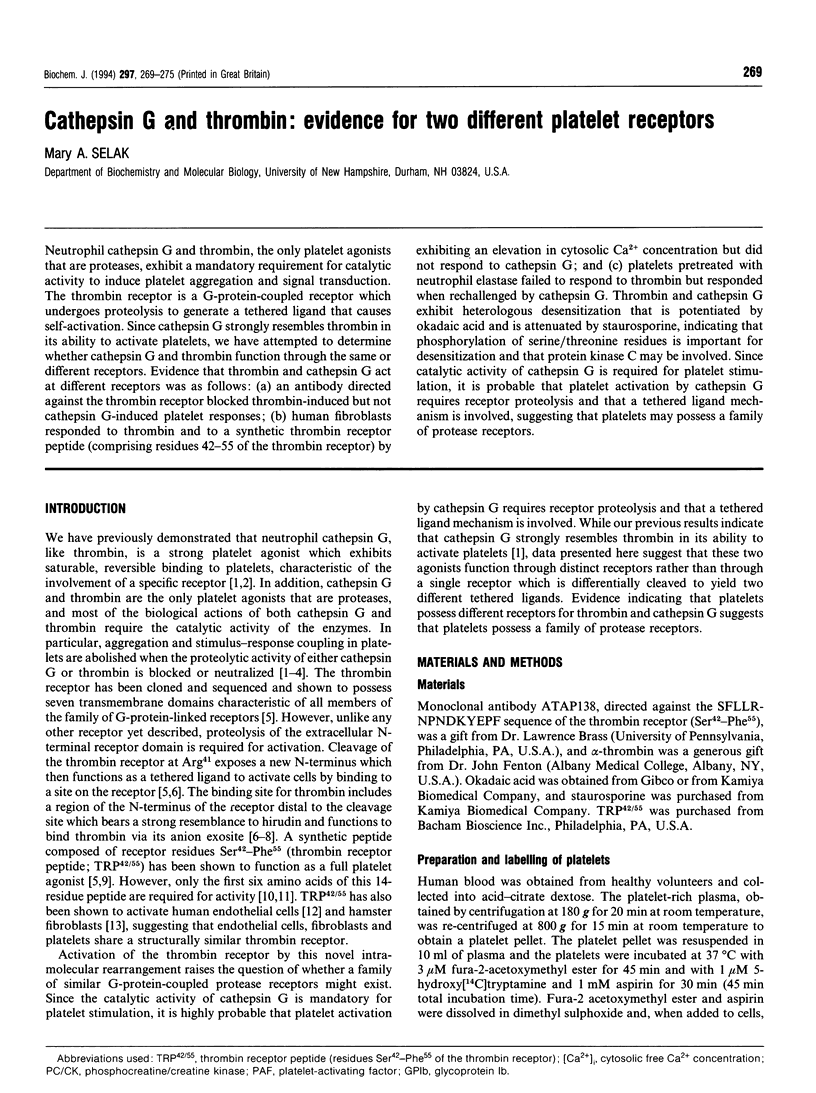
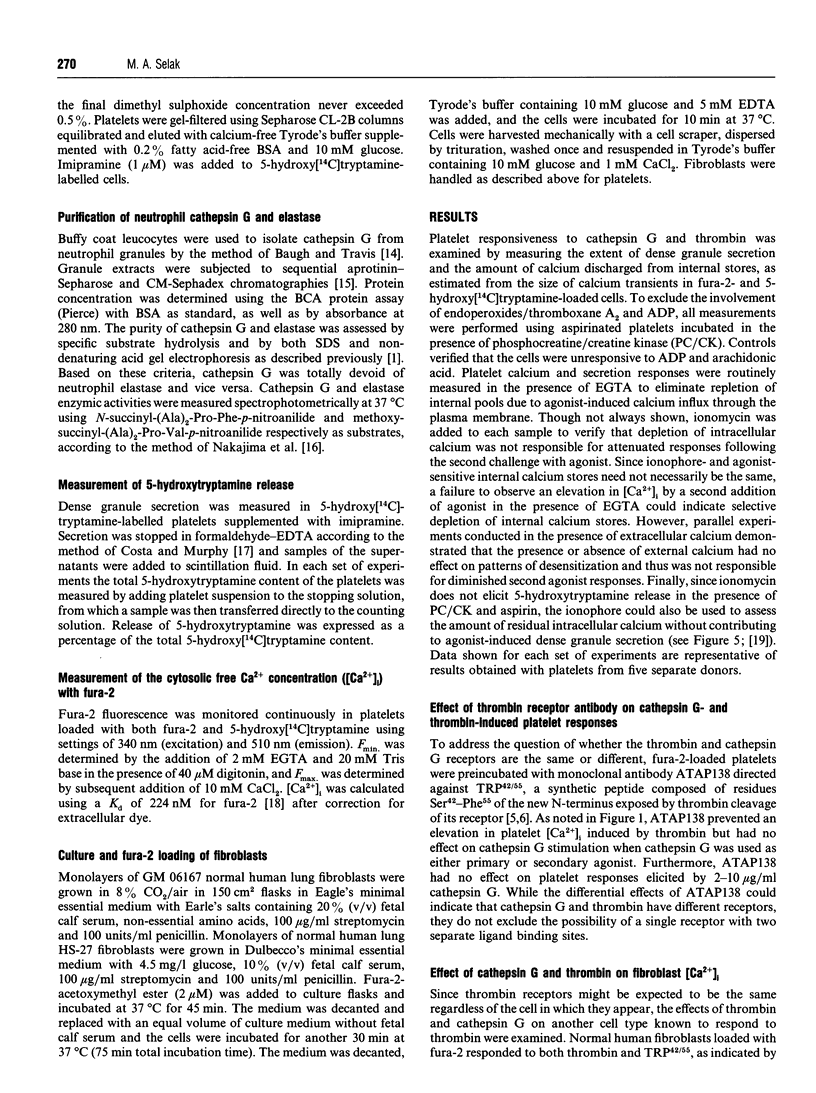
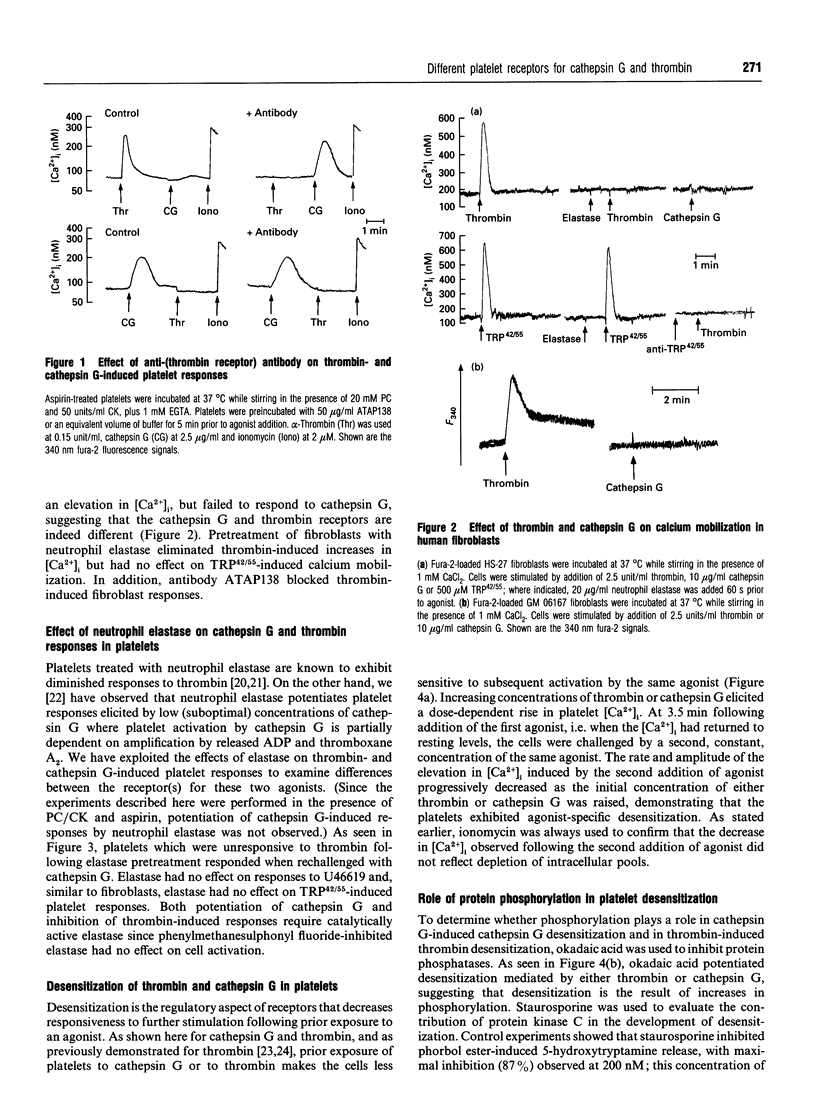
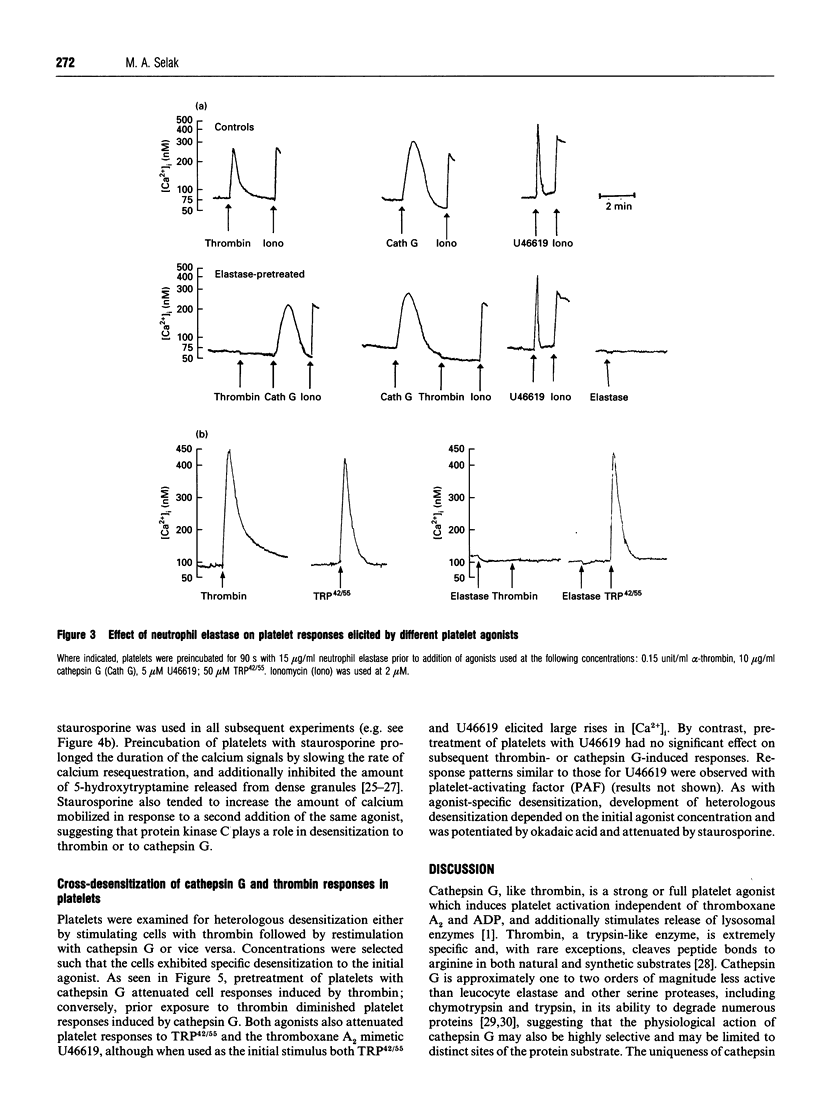
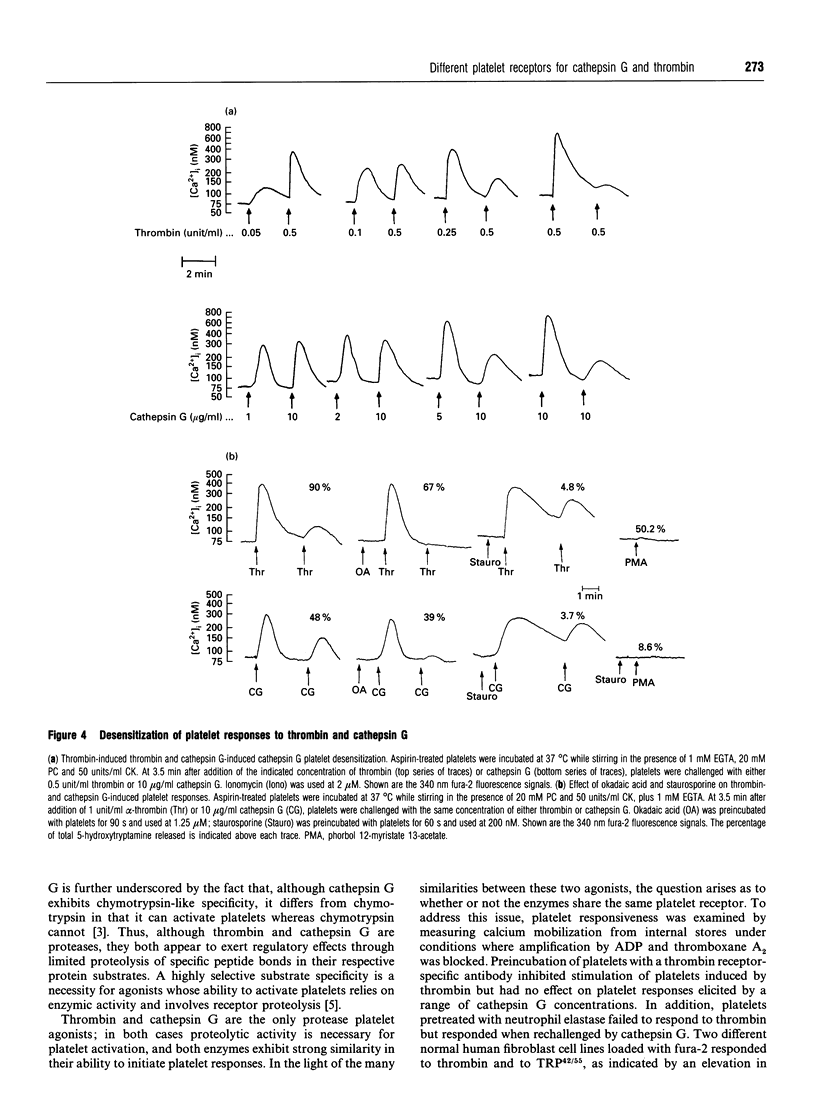
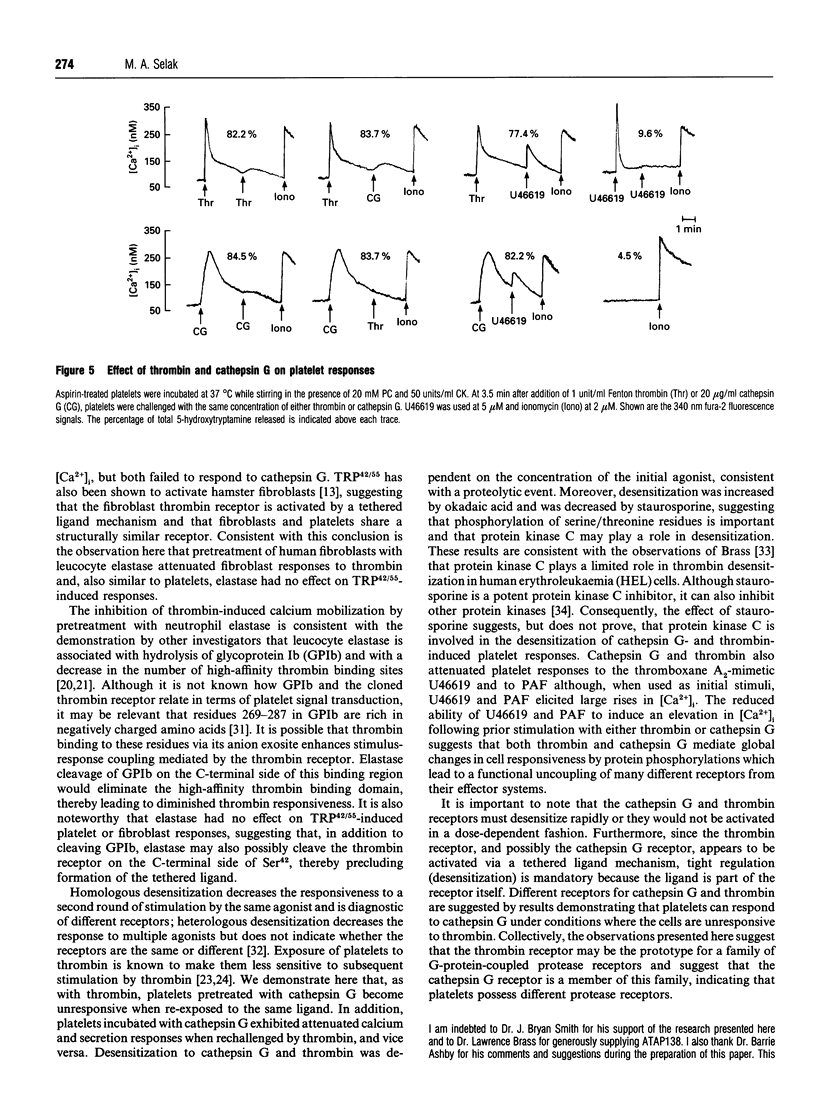
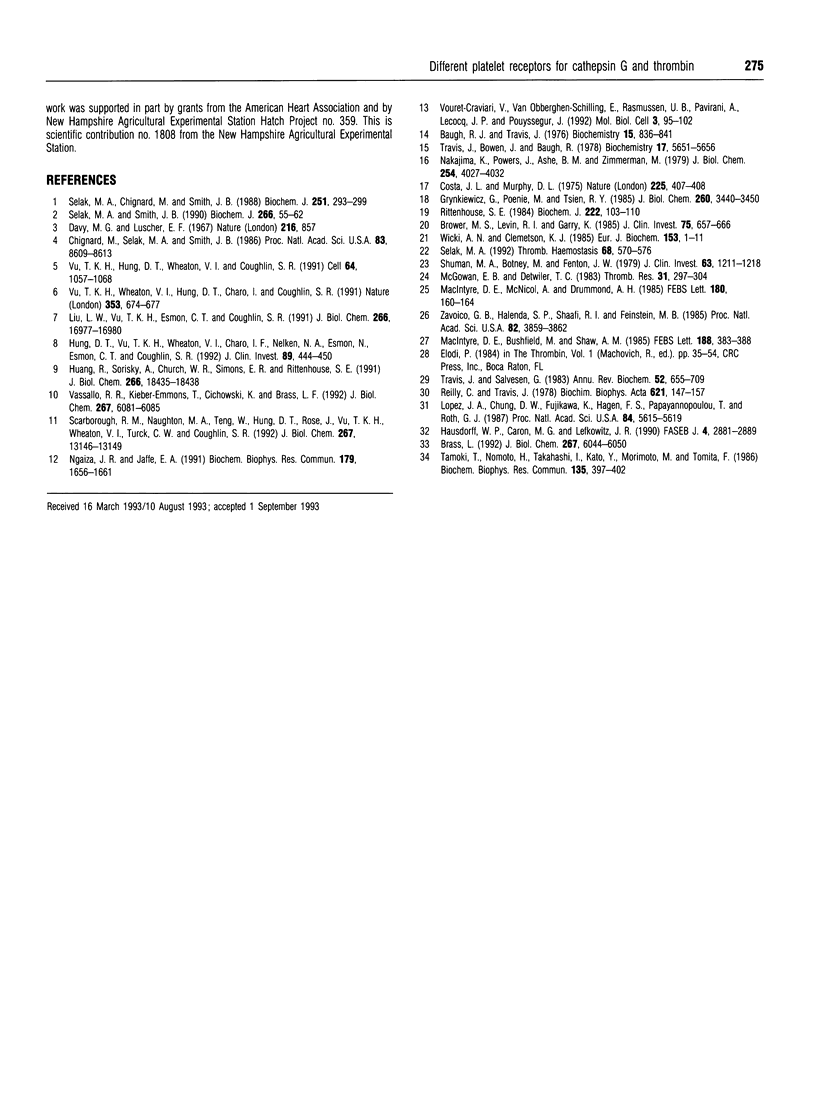
Selected References
These references are in PubMed. This may not be the complete list of references from this article.
- Baugh R. J., Travis J. Human leukocyte granule elastase: rapid isolation and characterization. Biochemistry. 1976 Feb 24;15(4):836–841. doi: 10.1021/bi00649a017. [DOI] [PubMed] [Google Scholar]
- Brass L. F. Homologous desensitization of HEL cell thrombin receptors. Distinguishable roles for proteolysis and phosphorylation. J Biol Chem. 1992 Mar 25;267(9):6044–6050. [PubMed] [Google Scholar]
- Brower M. S., Levin R. I., Garry K. Human neutrophil elastase modulates platelet function by limited proteolysis of membrane glycoproteins. J Clin Invest. 1985 Feb;75(2):657–666. doi: 10.1172/JCI111744. [DOI] [PMC free article] [PubMed] [Google Scholar]
- Chignard M., Selak M. A., Smith J. B. Direct evidence for the existence of a neutrophil-derived platelet activator (neutrophilin). Proc Natl Acad Sci U S A. 1986 Nov;83(22):8609–8613. doi: 10.1073/pnas.83.22.8609. [DOI] [PMC free article] [PubMed] [Google Scholar]
- Costa J. L., Murphy D. L. Platelet 5-HT uptake and release stopped rapidly by formaldehyde. Nature. 1975 May 29;255(5507):407–408. doi: 10.1038/255407a0. [DOI] [PubMed] [Google Scholar]
- Davey M. G., Lüscher E. F. Actions of thrombin and other coagulant and proteolytic enzymes on blood platelets. Nature. 1967 Dec 2;216(5118):857–858. doi: 10.1038/216857a0. [DOI] [PubMed] [Google Scholar]
- Grynkiewicz G., Poenie M., Tsien R. Y. A new generation of Ca2+ indicators with greatly improved fluorescence properties. J Biol Chem. 1985 Mar 25;260(6):3440–3450. [PubMed] [Google Scholar]
- Hausdorff W. P., Caron M. G., Lefkowitz R. J. Turning off the signal: desensitization of beta-adrenergic receptor function. FASEB J. 1990 Aug;4(11):2881–2889. [PubMed] [Google Scholar]
- Huang R. S., Sorisky A., Church W. R., Simons E. R., Rittenhouse S. E. "Thrombin" receptor-directed ligand accounts for activation by thrombin of platelet phospholipase C and accumulation of 3-phosphorylated phosphoinositides. J Biol Chem. 1991 Oct 5;266(28):18435–18438. [PubMed] [Google Scholar]
- Hung D. T., Vu T. K., Wheaton V. I., Charo I. F., Nelken N. A., Esmon N., Esmon C. T., Coughlin S. R. "Mirror image" antagonists of thrombin-induced platelet activation based on thrombin receptor structure. J Clin Invest. 1992 Feb;89(2):444–450. doi: 10.1172/JCI115604. [DOI] [PMC free article] [PubMed] [Google Scholar]
- Lopez J. A., Chung D. W., Fujikawa K., Hagen F. S., Papayannopoulou T., Roth G. J. Cloning of the alpha chain of human platelet glycoprotein Ib: a transmembrane protein with homology to leucine-rich alpha 2-glycoprotein. Proc Natl Acad Sci U S A. 1987 Aug;84(16):5615–5619. doi: 10.1073/pnas.84.16.5615. [DOI] [PMC free article] [PubMed] [Google Scholar]
- MacIntyre D. E., Bushfield M., Shaw A. M. Regulation of platelet cytosolic free calcium by cyclic nucleotides and protein kinase C. FEBS Lett. 1985 Sep 2;188(2):383–388. doi: 10.1016/0014-5793(85)80407-5. [DOI] [PubMed] [Google Scholar]
- MacIntyre D. E., McNicol A., Drummond A. H. Tumour-promoting phorbol esters inhibit agonist-induced phosphatidate formation and Ca2+ flux in human platelets. FEBS Lett. 1985 Jan 28;180(2):160–164. doi: 10.1016/0014-5793(85)81063-2. [DOI] [PubMed] [Google Scholar]
- McGowan E. B., Detwiler T. C. Characterization of the thrombin-induced desensitization of platelet activation by thrombin. Thromb Res. 1983 Jul 15;31(2):297–304. doi: 10.1016/0049-3848(83)90332-8. [DOI] [PubMed] [Google Scholar]
- Nakajima K., Powers J. C., Ashe B. M., Zimmerman M. Mapping the extended substrate binding site of cathepsin G and human leukocyte elastase. Studies with peptide substrates related to the alpha 1-protease inhibitor reactive site. J Biol Chem. 1979 May 25;254(10):4027–4032. [PubMed] [Google Scholar]
- Ngaiza J. R., Jaffe E. A. A 14 amino acid peptide derived from the amino terminus of the cleaved thrombin receptor elevates intracellular calcium and stimulates prostacyclin production in human endothelial cells. Biochem Biophys Res Commun. 1991 Sep 30;179(3):1656–1661. doi: 10.1016/0006-291x(91)91765-5. [DOI] [PubMed] [Google Scholar]
- Reilly C. F., Travis J. The degradation of human lung elastin by neutrophil proteinases. Biochim Biophys Acta. 1980 Jan 24;621(1):147–157. doi: 10.1016/0005-2795(80)90070-7. [DOI] [PubMed] [Google Scholar]
- Rittenhouse S. E. Activation of human platelet phospholipase C by ionophore A23187 is totally dependent upon cyclo-oxygenase products and ADP. Biochem J. 1984 Aug 15;222(1):103–110. doi: 10.1042/bj2220103. [DOI] [PMC free article] [PubMed] [Google Scholar]
- Scarborough R. M., Naughton M. A., Teng W., Hung D. T., Rose J., Vu T. K., Wheaton V. I., Turck C. W., Coughlin S. R. Tethered ligand agonist peptides. Structural requirements for thrombin receptor activation reveal mechanism of proteolytic unmasking of agonist function. J Biol Chem. 1992 Jul 5;267(19):13146–13149. [PubMed] [Google Scholar]
- Selak M. A., Chignard M., Smith J. B. Cathepsin G is a strong platelet agonist released by neutrophils. Biochem J. 1988 Apr 1;251(1):293–299. doi: 10.1042/bj2510293. [DOI] [PMC free article] [PubMed] [Google Scholar]
- Selak M. A. Neutrophil elastase potentiates cathepsin G-induced platelet activation. Thromb Haemost. 1992 Nov 10;68(5):570–576. [PubMed] [Google Scholar]
- Selak M. A., Smith J. B. Cathepsin G binding to human platelets. Evidence for a specific receptor. Biochem J. 1990 Feb 15;266(1):55–62. doi: 10.1042/bj2660055. [DOI] [PMC free article] [PubMed] [Google Scholar]
- Shuman M. A., Botney M., Fenton J. W., 2nd Thrombin-induced platelet secretion. Further evidence for a specific pathway. J Clin Invest. 1979 Jun;63(6):1211–1218. doi: 10.1172/JCI109416. [DOI] [PMC free article] [PubMed] [Google Scholar]
- Tamaoki T., Nomoto H., Takahashi I., Kato Y., Morimoto M., Tomita F. Staurosporine, a potent inhibitor of phospholipid/Ca++dependent protein kinase. Biochem Biophys Res Commun. 1986 Mar 13;135(2):397–402. doi: 10.1016/0006-291x(86)90008-2. [DOI] [PubMed] [Google Scholar]
- Travis J., Bowen J., Baugh R. Human alpha-1-antichymotrypsin: interaction with chymotrypsin-like proteinases. Biochemistry. 1978 Dec 26;17(26):5651–5656. doi: 10.1021/bi00619a011. [DOI] [PubMed] [Google Scholar]
- Travis J., Salvesen G. S. Human plasma proteinase inhibitors. Annu Rev Biochem. 1983;52:655–709. doi: 10.1146/annurev.bi.52.070183.003255. [DOI] [PubMed] [Google Scholar]
- Vassallo R. R., Jr, Kieber-Emmons T., Cichowski K., Brass L. F. Structure-function relationships in the activation of platelet thrombin receptors by receptor-derived peptides. J Biol Chem. 1992 Mar 25;267(9):6081–6085. [PubMed] [Google Scholar]
- Vouret-Craviari V., Van Obberghen-Schilling E., Rasmussen U. B., Pavirani A., Lecocq J. P., Pouysségur J. Synthetic alpha-thrombin receptor peptides activate G protein-coupled signaling pathways but are unable to induce mitogenesis. Mol Biol Cell. 1992 Jan;3(1):95–102. doi: 10.1091/mbc.3.1.95. [DOI] [PMC free article] [PubMed] [Google Scholar]
- Vu T. K., Hung D. T., Wheaton V. I., Coughlin S. R. Molecular cloning of a functional thrombin receptor reveals a novel proteolytic mechanism of receptor activation. Cell. 1991 Mar 22;64(6):1057–1068. doi: 10.1016/0092-8674(91)90261-v. [DOI] [PubMed] [Google Scholar]
- Vu T. K., Wheaton V. I., Hung D. T., Charo I., Coughlin S. R. Domains specifying thrombin-receptor interaction. Nature. 1991 Oct 17;353(6345):674–677. doi: 10.1038/353674a0. [DOI] [PubMed] [Google Scholar]
- Wicki A. N., Clemetson K. J. Structure and function of platelet membrane glycoproteins Ib and V. Effects of leukocyte elastase and other proteases on platelets response to von Willebrand factor and thrombin. Eur J Biochem. 1985 Nov 15;153(1):1–11. doi: 10.1111/j.1432-1033.1985.tb09259.x. [DOI] [PubMed] [Google Scholar]
- Zavoico G. B., Halenda S. P., Sha'afi R. I., Feinstein M. B. Phorbol myristate acetate inhibits thrombin-stimulated Ca2+ mobilization and phosphatidylinositol 4,5-bisphosphate hydrolysis in human platelets. Proc Natl Acad Sci U S A. 1985 Jun;82(11):3859–3862. doi: 10.1073/pnas.82.11.3859. [DOI] [PMC free article] [PubMed] [Google Scholar]


